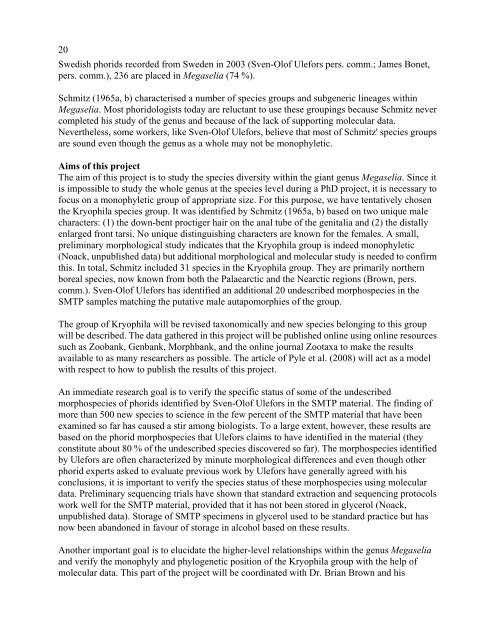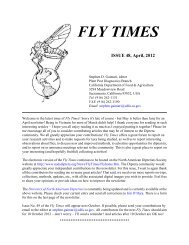Fly Times Issue 43, October 2009 - North American Dipterists Society
Fly Times Issue 43, October 2009 - North American Dipterists Society
Fly Times Issue 43, October 2009 - North American Dipterists Society
Create successful ePaper yourself
Turn your PDF publications into a flip-book with our unique Google optimized e-Paper software.
20<br />
Swedish phorids recorded from Sweden in 2003 (Sven-Olof Ulefors pers. comm.; James Bonet,<br />
pers. comm.), 236 are placed in Megaselia (74 %).<br />
Schmitz (1965a, b) characterised a number of species groups and subgeneric lineages within<br />
Megaselia. Most phoridologists today are reluctant to use these groupings because Schmitz never<br />
completed his study of the genus and because of the lack of supporting molecular data.<br />
Nevertheless, some workers, like Sven-Olof Ulefors, believe that most of Schmitz' species groups<br />
are sound even though the genus as a whole may not be monophyletic.<br />
Aims of this project<br />
The aim of this project is to study the species diversity within the giant genus Megaselia. Since it<br />
is impossible to study the whole genus at the species level during a PhD project, it is necessary to<br />
focus on a monophyletic group of appropriate size. For this purpose, we have tentatively chosen<br />
the Kryophila species group. It was identified by Schmitz (1965a, b) based on two unique male<br />
characters: (1) the down-bent proctiger hair on the anal tube of the genitalia and (2) the distally<br />
enlarged front tarsi. No unique distinguishing characters are known for the females. A small,<br />
preliminary morphological study indicates that the Kryophila group is indeed monophyletic<br />
(Noack, unpublished data) but additional morphological and molecular study is needed to confirm<br />
this. In total, Schmitz included 31 species in the Kryophila group. They are primarily northern<br />
boreal species, now known from both the Palaearctic and the Nearctic regions (Brown, pers.<br />
comm.). Sven-Olof Ulefors has identified an additional 20 undescribed morphospecies in the<br />
SMTP samples matching the putative male autapomorphies of the group.<br />
The group of Kryophila will be revised taxonomically and new species belonging to this group<br />
will be described. The data gathered in this project will be published online using online resources<br />
such as Zoobank, Genbank, Morphbank, and the online journal Zootaxa to make the results<br />
available to as many researchers as possible. The article of Pyle et al. (2008) will act as a model<br />
with respect to how to publish the results of this project.<br />
An immediate research goal is to verify the specific status of some of the undescribed<br />
morphospecies of phorids identified by Sven-Olof Ulefors in the SMTP material. The finding of<br />
more than 500 new species to science in the few percent of the SMTP material that have been<br />
examined so far has caused a stir among biologists. To a large extent, however, these results are<br />
based on the phorid morphospecies that Ulefors claims to have identified in the material (they<br />
constitute about 80 % of the undescribed species discovered so far). The morphospecies identified<br />
by Ulefors are often characterized by minute morphological differences and even though other<br />
phorid experts asked to evaluate previous work by Ulefors have generally agreed with his<br />
conclusions, it is important to verify the species status of these morphospecies using molecular<br />
data. Preliminary sequencing trials have shown that standard extraction and sequencing protocols<br />
work well for the SMTP material, provided that it has not been stored in glycerol (Noack,<br />
unpublished data). Storage of SMTP specimens in glycerol used to be standard practice but has<br />
now been abandoned in favour of storage in alcohol based on these results.<br />
Another important goal is to elucidate the higher-level relationships within the genus Megaselia<br />
and verify the monophyly and phylogenetic position of the Kryophila group with the help of<br />
molecular data. This part of the project will be coordinated with Dr. Brian Brown and his

















